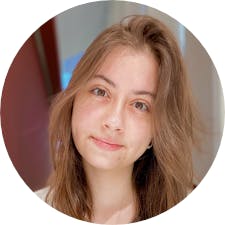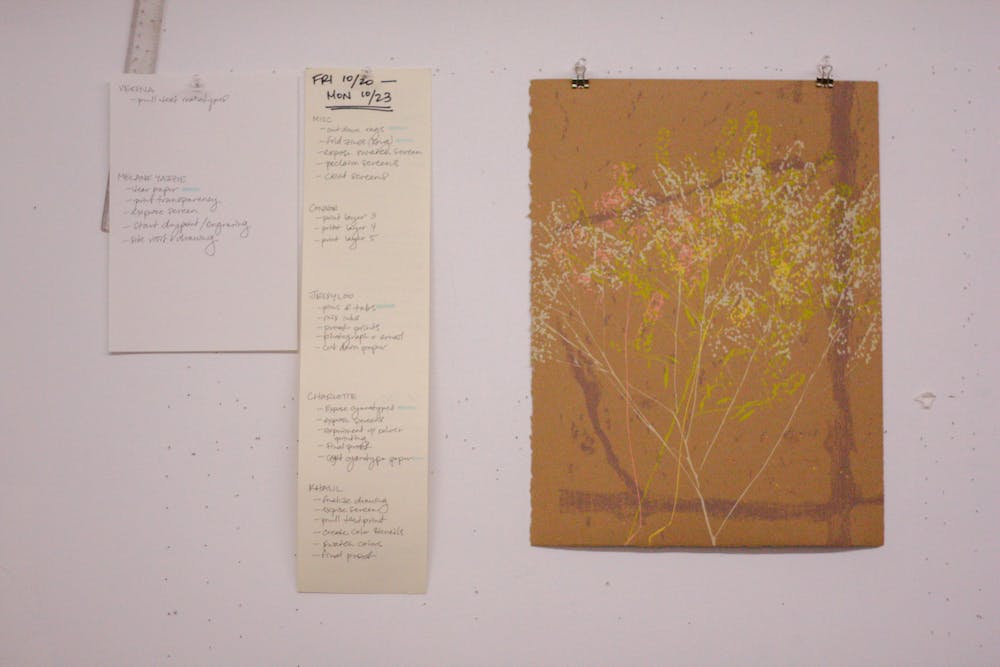While conducting research on subjects ranging from salt marshes to plant-soil relationships, Artist Heather McMordie was inspired to push the boundaries of herbarium collections and explore intimate narratives about people’s relationships with plants.
This past spring, McMordie, who is also an adjunct lecturer in visual arts, set out to turn her idea into reality by launching the Providence Community Herbarium. The project invited twelve Providence residents to submit their “plant stories” and work together with McMordie to produce prints inspired by these tales.
Last Friday, as the project moved into full production mode, McMordie welcomed The Herald into her studio. While setting up the space — organizing the prints in progress, mixing vibrant paints and putting on soft tunes — McMordie explained that collaborators would be coming in to work on their projects. “It’s going to be a studio party,” she said.

“I've tried to do my best to either invite or spread the word to collaborators from a variety of different neighborhoods so that there are people contributing stories from all across the different urban ecosystems within Providence,” McMordie explained.
Collaborating with newcomers and experienced artists alike “has been a really wonderful way to get to know people” in a safe and rewarding creative space, she added. “We also have a shared interest so … I just get to be myself in the studio and hopefully invite people to do the same.”
McMordie’s project received funding from the Interlace Grant Fund, which supports Providence-based artists and allowed her to provide local collaborators “a small stipend for their time and creative energy.”
Vessna Scheff, a recent graduate from the Rhode Island School of Design master’s painting program, first connected with McMordie through a mutual friend. Now, Scheff is working on a drawing that depicts an avocado seed growing in a glass on a windowsill for McMordie’s project.
Scheff’s drawing will be turned into monoprints, a technique “in which an image is made from a smooth surface or ‘plate’ coated in printing ink such as a sheet of glass or metal,” according to the National Galleries of Scotland website.
“My mom used to grow avocado seeds throughout the house,” Scheff said. “It’s just this very interesting memory I had. … It was just a beautiful thing to take a seat” and watch the seeds grow.
Scheff’s intimate connection to the subject of her print represents exactly the types of narratives McMordie aims to center through her project.
The Providence Community Herbarium involves people “who aren’t necessarily ecologists or scientists that are collecting plants and telling stories,” looking beyond the academic contexts of typical herbaria, McMordie said. “Our relationship with plants … extends beyond just the scientific value of those plants.”
McMordie’s ultimate goal is to create an accessible project that invites people to recognize the plant life around them. “Hearing the stories that we all have to tell about these plants,” she said, “allows us to take ownership of our local environments.”
High school student Khalil Lloréns learned about the Providence Community Herbarium through a family friend. Interested in nature and native plants, he decided to submit a story. “It seemed like a really cool opportunity to make a piece about something I care about,” he said.
With his print, Lloréns wants to “showcase how many different types of milkweeds there are,” he explained. Lloréns’s art aims to blend scientific drawings that highlight the importance of milkweed to local ecosystems with his intimate relationship with the plant.
Similar to Lloréns’s print — which will feature a vibrant color palette of pinks, purples and greens — McMordie has always been interested in blending scientific research and art.

“It has always been my goal to have arts and science in meaningful conversation with one another,” she said. “As I thought about it, I realized it would be really difficult to incorporate art in the way I wanted to do it into a science program,” but incorporating science into art projects felt more possible, she said.
This project has also allowed students like Jaden Bleier ’23, McMordie’s studio assistant, former printmaking student and current teaching assistant, to learn new skills: “I feel like there’s always more to learn,” Bleier said.
Designer Charlotte Powning, for example, was able to build on her skills as an “amateur photographer” while working on her print for McMordie’s project.
The first step in creating Powning’s prints was making cyanotypes using samples of moonflowers. Powning then set out to photograph her chosen plant — the moonflower — around her neighborhood. Now, the photographs have been printed on a transparent surface so they can be placed together with the cyanotypes.
“This was the house that I lived in for two years prior to moving,” Powning said, pointing to one of the photographs. The moonflower on the sidewalk “would grow for several months on end and get really huge. … I just really like the plant and how resilient it is.”
Conor MacDonald MA’20, a law clerk and legal researcher, similarly chose a plant he admires due to its resiliency. For MacDonald, pepperweed, a plant often found in the city’s untended areas sidewalk cracks, is a “reminder of the generosity, unpredictability and potential of city life, and the rewards of giving some attention to something we mostly ignore.”
The print MacDonald is designing with McMordie will highlight how pepperweed changes with the seasons, a process represented by a varied color scheme: “The bright green spring and summer color, the late summer straw-gold, and the tinges of magenta which the seeds develop in the fall,” he explained.

Through her collaborations, McMordie has begun to notice more and more plants around her: “Now that I can recognize (a plant) because this person has told me about it, I value it more,” she said.
And McMordie’s project is still expanding. Beyond working on the prints, she plans to create a zine about the Providence Community Herbarium that will be distributed in spaces like public libraries and community gardens as a means of engaging “Providence populations on environmental issues and environmental care.”
McMordie is also planning to hold an exhibition for the project in March. During the exhibition, the prints will be accompanied by a letter-pressed text from each artist about their plant stories.
For McMordie, the project is “an opportunity to learn from one another and, in valuing our community of people, start to value the community of plant life and non-human life around us.”

Julia Vaz was the managing editor of newsroom and vice president on The Herald's 134th Editorial Board. Previously, she covered environment and crime & justice as a Metro editor. A concentrator in political science and modern culture and media, she loves watching Twilight (as a comedy) and casually dropping the fact she is from Brazil.





